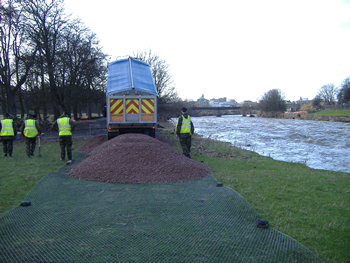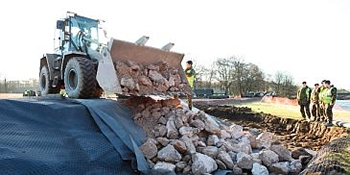 Following the 21 November flood destruction of the town’s bridges over the River Derwent in Workington, Cumbria, Army Royal Engineers have used Tensar International’s TriAx™ geogrid to help construct new bridge abutments for a 40 ton temporary footbridge. Connecting the north and south of the town, the actual bridge will take a week to assemble, and is expected to be in place for the Monday morning school run.
Following the 21 November flood destruction of the town’s bridges over the River Derwent in Workington, Cumbria, Army Royal Engineers have used Tensar International’s TriAx™ geogrid to help construct new bridge abutments for a 40 ton temporary footbridge. Connecting the north and south of the town, the actual bridge will take a week to assemble, and is expected to be in place for the Monday morning school run.
“We were contacted on the 26th to assist with design of the abutments and the assembly platform, the TriAx™ geogrid was delivered on the next morning so that installation could start the same day,” commented David Cashman, Commercial Marketing Manager for Tensar International. “We were very pleased to play our part in the operation and help restore a semblance of normality to the town’s infrastructure.”
“Tensar responded very quickly to our requirements,” confirmed Major Phillip Curtis, MOD spokesman. “Both in contributing to the design and specification and getting the geogrid to us within a day of our call were magnificent. Helping us to assist the people and council of Workington has been very worthwhile.”
David Cashman continued: “Foundations mechanically stabilised with geogrids are widely used in many applications including permanent and temporary bridge abutments as an alternative to piling and other techniques. Apart from the speed of construction, one important advantage is that the geogrid construction is loadbearing immediately, there is no delay caused by waiting for concrete to cure. The bridge deck can be installed as soon as it is ready, and the advantages of speed are obvious in a crisis.
 “Use of geogrid reinforced soil structures is very well established in civil engineering, but its unique advantages of speed and simplicity are very relevant to emergency response situations. Tensar have also offered assistance in the repair and re-instatement of bridges, roads, embankments, slopes and other structures in the Cumbria area.”
“Use of geogrid reinforced soil structures is very well established in civil engineering, but its unique advantages of speed and simplicity are very relevant to emergency response situations. Tensar have also offered assistance in the repair and re-instatement of bridges, roads, embankments, slopes and other structures in the Cumbria area.”
The river banks of the Derwent in Workington consist of sandy clay soil with poor load-bearing properties, necessitating careful design for the footbridge foundations. By constructing the abutment bank seat supports using TriAx™ geogrid layered with angular aggregate, the need for extensive piling and foundation work was avoided.
In addition, to allow assembly on site and rapid installation of the bridge in one piece, a temporary TriAx™ platform of about 75 meters by 20 metres was required. After the bridge is assembled, the platform supports 95 tons in load as the bridge is cantilevered out over rollers across the river, using a special army vehicle, until it rests on the abutments on the far bank. The platform must minimise settlement due to the load, otherwise the bridge may not have sufficient height to reach the opposite landing rollers and abutments.
Captain Caroline Graham-Brown, Royal Engineer in the project team explained:
"Normally the bridge would be built on existing abutments, or temporary abutments on a river bank. In this case, the saturated topsoil was stripped down to the sandy clay below, and the platform was built up using the TriAx™ geogrid. Over a geotextile separator at the base, a 6.1 metre by 1.2 metre platform was built with four layers of geogrid and at least 600mm of DoT Type 1 sub-base aggregate, then capped with 1 metre concrete and a steel grillage plate and an SHS ground beam assembly.
“The designed load-bearing performance is 85 kN/m2, and the structure is designed to last at least six months. The MOD has used Tensar geogrid solutions in the past for infrastructure projects with excellent results.”
Tensar’s unique TriAx™ geogrid is a stiff polymer geogrid based on an equilateral triangle structure, which interlocks with the aggregate fill particles to form a stiff, mechanically stabilised layer. Load full-scale bearing capacity testing carried out by the Building Research Establishment (BRE) (amongst other third parties) shows that its increased stiffness and confinement results in an even greater load distribution ability compared with Tensar biaxial geogrids.











